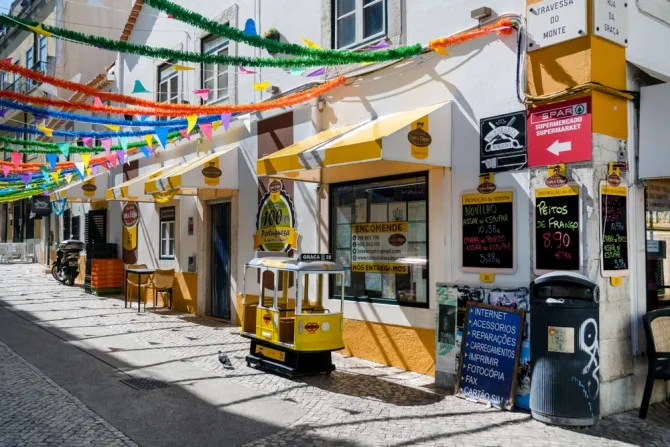ACI Digital, Aug 4, 2023 / 16:30 pm
Pope Francis’ first speech in Lisbon, Portugal, where he arrived on Aug. 2 for World Youth Day, referenced a small neighborhood in Lisbon — Mouraria — unknown to most of the world.
What is Mouraria? Mouraria is a Lisbon neighborhood where “people from more than 60 countries live in harmony,” according to the pope.
The approximately 6,000 inhabitants of the neighborhood today come from dozens of different countries, especially China, India, Bangladesh, Pakistan, and Mozambique.
“I greet you cordially, and I thank you, Mr. President, for your welcome and kind words. I am happy to have come to Lisbon, this city of encounter which embraces many peoples and cultures, and which, in these days, is even more global: in a certain sense, it has become the capital of the world,” Pope Francis remarked.
“This very much befits its multiethnic and multicultural character — I think of the Mouraria district, where people from more than 60 countries live together in harmony — and it displays the cosmopolitan face of Portugal, grounded in a desire to be open to the world and to explore it, setting sail towards ever new and vaster horizons.”
How Mouraria came to be
Mouraria was born practically at the same time as Portugal itself.
Times were then less peaceful. On Oct. 25, 1147, Dom Afonso Henriques took Lisbon from the Muslims after a siege of almost four months and, as Afonso I, became the first king of Portugal.
The region extending from Martim Moniz Square to the slopes of São Jorge Castle became the only place of residence for the remaining Muslims. These Muslims, descendants of seventh-century conquerors from North Africa, were referred to as the Moors, or “Mouros” in Portuguese.
They stayed in the region that would take their name — Mouraria — until their expulsion by King Manuel in 1496.
In the decades after the Christianization of the area, the newly created Society of Jesus opened its first school in Portugal in this neighborhood in 1553, from which it would launch its evangelistic efforts in the region.
The neighborhood is still known for its historic Catholic churches, the first of which, São Sebastião (St. Sebastian), was built in 1505 as a protective against the plague.
Later other chapels in the area, such as Nossa Senhora da Saúde (Our Lady of Good Health), associated with miraculous protection from the plague, would inspire religious processions that continue to this day on the first Sunday in May.
The Church of São Cristóvão, one of only a handful of buildings and monuments whose works of art survived the 1755 earthquake that devastated Lisbon, would be raised to the dignity of a royal chapel in 1861.
Marginalization, renaissance, degradation, and gentrification
During the 19th and 20th centuries, Mouraria has been the birthplace of one of the most distinctly Portuguese cultural products: the “fado,” the melancholy bohemian soundtrack of Lisbon nights. Fernando Maurício, one of the most influential “fadistas,” was born in Mouraria in 1933, as was the song “Ai, Mouraria,” recorded by many Portuguese musicians through the years.
(Story continues below)
Nonetheless, Mouraria started the 21st century as a very degraded neighborhood.
“The marginalization of the Mouraria neighborhood persisted for centuries until the turn of the new millennium,” says the website of the Renovar a Mouraria Foundation, which has been active since 2008 in the neighborhood’s recovery. “In the first decade of the 21st century, Mouraria, the birthplace of fado and home to several waves of immigration, was perceived as an unsafe place, torn by economic and social tensions.”
According to the foundation, “living as an abandoned place in the city, issues related to drug trafficking and consumption in broad daylight, broken families, dirty streets, and poverty were normality.”
In 2012, the Lisbon City Council started to improve the public space and implement a community development plan that significantly improved the neighborhood.
The foundation runs “Portuguese courses for migrants; study support; the citizenship office, which supports migrants with documentation; the Migrantour, which are guided visits to the neighborhood in which the guides are properly prepared migrants.”
The multicultural neighborhood, however, faces the risk of losing its character because of the gentrification and tourism that have become a significant source of revenue for Lisbon.
Filipa Bolotinha, the general coordinator of Renovar a Mouraria, told the newspaper Diário de Notícias in June that “it is increasingly difficult for migrants to continue living in Mouraria. Now the houses are rehabilitated, but they are no longer available because of the prices.”
Understanding Mouraria in light of WYD
The mix of religious traditions, the harsh reality of migration, the complexity of survival in urban settings, and Mouraria’s historic contributions to the culture of Portugal give a compelling quality to the pope’s words concerning harmony.
It may be that the Holy Father wants to see in Mouraria what he described later in his speech as his hope for Europe:
“I dream of a Europe, the heart of the West, which employs its immense talents to settling conflicts and lighting lamps of hope; a Europe capable of recovering its youthful heart, looking to the greatness of the whole and beyond its immediate needs; a Europe inclusive of peoples and persons, without chasing after ideologies and forms of ideological colonization.”
How to realize such a dream? In the Gospel presented to the young people at World Youth Day, according to Pope Francis.
“Young people from around the world, who long for unity, peace, and fraternity, urge us to make their good dreams come true. They are taking to the streets, not to cry out in anger but to share the hope of the Gospel,” he said.
In some way, the hundreds of thousands of pilgrims from every land, and even others from different faiths, exist as the “neighborhood of harmony” at World Youth Day. They are challenged and made hopeful by Mouraria, “to set sail together towards the future” with greater charity, care for our common home, and more openness to a life defined by Gospel values.
This article was originally published by ACI Digital, CNA’s Portuguese-language news partner. It has been translated and adapted by CNA.






